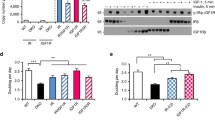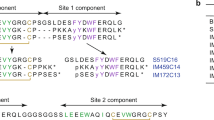Abstract
The insulin receptor family in mammals includes the receptors for insulin, insulin-like growth factor I (IGF-I), and the insulin receptor-related receptor (IRR), a receptor whose sequence is homologous to the sequences of the other two receptors but whose ligand is unknown (Fig. 1) (1). Another potential receptor in this family is the receptor for relaxin, a hormone whose structure is related to that of insulin (2). In addition, other members of this receptor family could exist for IGF-I and the highly related IGF-II. Although the cDNA and gene for one receptor which binds IGF-I with high affinity has been isolated (3), several pieces of data suggest that there may be other related IGF receptors. For example, although the receptor expressed from this cDNA had high affinity for IGF-I and IGF-II but almost 1000-fold weaker affinity for insulin (4), several reports in the literature have indicated that there are IGF receptors with a much higher affinity for insulin or a much weaker affinity for IGF-II (5, 6). Some of these studies may have been affected by the presence of hybrid insulin-IGF-I receptors (7). In addition, expression of the apparently same cDNA for the IGF-I receptor in another cell type led to the formation of a receptor which had high affinity for IGF-I and weak affinity for IGF-II when binding studies were performed on whole cells but which bound IGF-I and II almost equally when binding studies were performed in cell lysates (8). In addition, several monoclonal antibodies to the IGF-I receptor were found to stimulate an increase in the affinity of the IGF-I receptor for insulin almost to the level of the insulin receptor (9). These results suggest that the same IGF receptor can bind the IGFs and insulin with different relative affinities depending on the environment of the receptor in the cell membrane. Thus, it is not clear at the present time whether another IGF receptor exists or whether these different binding data can be explained by the present IGF-I receptor interacting with other molecules in different cell backgrounds.
Access this chapter
Tax calculation will be finalised at checkout
Purchases are for personal use only
Preview
Unable to display preview. Download preview PDF.
Similar content being viewed by others
References
P. Shier and V.M. Watt, Primary structure of a putative receptor for a ligand of the insulin family, J. Biol. Chem. 264:14605–14608 (1989).
C. Schwabe and E.E. Bullesbach, Relaxin, Comp. Biochem. Physiol. 96B:15–21 (1990).
A. Ullrich, A. Gray, A.W. Tam, T. Yang-Feng, M. Tsubokawa, C.Collins, W. Henzel, T. Le Bon, S. Kathuria, E. Chen, S. Jacobs, U. Francke, J. Ramachandran, and Y. Fujita-Yamaguchi, Insulinlike growth factor I receptor primary structure: comparison with insulin receptor suggests structural determinants that define functional specificity, EMBO J. 5:2503–2512 (1986).
R.A. Roth, G. Steele-Perkins, J. Hari, C. Stover, S. Pierce, J. Turner,J.C. Edman, and W.J. Rutter, Insulin and insulin-like growth factor receptors and responses, Cold Spring Harbor Symposia on Quantitative Biology, Vol. L111:537–543 (1988).
R.S. Garofalo and B. Barenton, Functional and immunological distinction between insulin-like growth factor I receptor subtypes in KB cells, J. Biol. Chem. 267:11470–11475 (1992).
G. Milazzo, C.C.Yip, B.A. Maddux, R. Vigneri, and I.D. Goldfine, High-affinity insulin binding to an atypical insulin-like growth factor-I receptor in human breast cancer cells, J. Clin. Invest. 89:899–908 (1992).
C.P. Moxham, V. Duronio, and S. Jacobs, Insulin-like growth factor I receptor ß-subunit heterogeneity, J. Biol. Chem. 264:13238–13244 (1989).
E.L. Germain-Lee, M. Janicot, R. Lammers, A. Ullrich, and S.J.Casella, Expression of a type I insulin-like growth factor receptor with low affinity for insulin-like growth factor II, Biochem. J. 281:413–417 (1992).
M.A. Soos, C.E. Field, R. Lammers, A. Ullrich, B. Zhang, R.A. Roth,A.S. Andersen, T. Kjeldsen, and K. Siddle, A panel of monoclonal antibodies for the type I insulin-like growth factor receptor, J. Biol. Chem. 267:12955–12963 (1992).
R. Fernandez-Almonacid and O.M. Rosen, Structure and ligand specificity of the Drosophila melanogaster insulin receptor, Molec. Cell. Biol. 7:2718–2727 (1987).
Y. Nishida, M. Hata, Y. Nishizuka, W.J. Rutter, and Y. Ebina, Cloning of a drosophila cDNA encoding a polypeptide similar to the human insulin receptor precursor, Biochem. Biophys. Res. Comm. 141:474–481 (1986).
K. Maruyama, H. Hietter, H. Nagasawa, A. Isogai, S. Tamura, A.Suzuki, and H. Ishizaki, Isolation and primary structure of bombyxin-IV, a novel molecular species of bombyxin from the silkworm, Bombyx mori, Agric. Biol. Chem. 52:3035–3041 (1988).
W.P.M. Geraerts, A.B. Smit, K.W. Li, E. Vreugdenhil, and H. van Heerikhuizen, Neuropeptide Gene Families that Control Reproductive Behaviour and Growth in Molluscs, in: Current Aspects of the Neurosciences, N.N. Osborne, ed., The Macmillan Press Ltd, New York (1991).
B. Zhang, and R.A. Roth, Binding properties of chimeric insulin receptors containing the cysteine-rich domain of either the insulin-like growth factor-I receptor or the insulin receptorrelated receptor, Biochemistry 30:5113–5117 (1991).
A.S. Andersen, T. Kjeldsen, F.C. Wiberg, H. Vissing, L. Schaffer, J.S.Rasmussen, P. De Meyts, and N.P.H. Moller, Identification of determinants that confer ligand specificity on the insulin receptor, J. Biol. Chem. 267:13681–13686 (1992).
R. Schumacher, M.A. Soos, J. Schlessinger, D. Brandenburg, K.Siddle, and A. Ullrich, Signaling-competent receptor chimeras allow mapping of major insulin receptor binding domain determinants, J. Biol. Chem. 268:1087–1094 (1993).
B. Zhang and R.A. Roth, A region of the insulin receptor important for ligand binding (residues 450–601) is recognized by patients’ autoimmune antibodies and inhibitory monoclonal antibodies, Proc. Natl. Acad. Sci. USA 88:9858–9862 (1991).
Y. Takata, N.J.G. Webster, and J.M. Olefsky, Mutation of the two carboxyl-terminal tyrosines results in an insulin receptor with normal metabolic signaling but enhanced mitogenic signaling properties, J. Biol. Chem. 266:9135–9139 (1991).
B. Zhang and R.A. Roth, The insulin receptor-related receptor, J.Biol. Chem. 267:18320–18328 (1992).
K. Yonezawa, S. Pierce, C. Stover, M. Aggerbeck, W.J. Rutter, and R.A. Roth, Endogenous substrates of the insulin receptor: studies with cells expressing wild-type and mutant receptors, in: Molecular Biology and Physiology of Insulin and Insulinlike Growth Factors, M.K. Raizada and D. LeRoith, eds., Plenum Press, New York (1991).
S.E. Mulroney, A. Haramati, H. Werner, C. Bondy, C.T. Roberts, Jr., and D. LeRoith, Altered expression of insulin-like growth factor-I (IGF-I) and IGF receptor genes after unilateral nephrectomy in immature rats, Endocrinology 130:249–256 (1992).
H. Werner, Z. Shen-Orr, B. Stannard, B. Burguera, C.T. Roberts, Jr., and D. LeRoith, Experimental diabetes increases insulin-like growth factor I and II receptor concentration and gene expression in kidney, Diabetes 39:1490–1497 (1990).
K.S. Kovacina and R.A. Roth, Identification of SHC as a substrate of the insulin receptor kinase distinct from the GAP-associated 62 kDa tyrosine phosphoprotein, Biochem. Biophys. Res. Comm. ,in press.
H. Kurachi, K. Jobo, M. Ohta, T. Kawasaki, and N. Itoh, A new member of the insulin receptor family, insulin receptorrelated receptor, is expressed preferentially in the kidney, Biochem. Biophys. Res. Comm. 187:934–939 (1992).
P. Shier and V.M. Watt, Tissue-specific expression of the rat insulin receptor-related receptor gene, Molec. Endocrinology 6:723–729.
R.R. Reinhardt, E. Chin, B. Zhang, R.A. Roth, and C.A. Bondy, Insulin receptor-related receptor mRNA is focally expressed in sensory neurons and renal distal tubule, Endocrinology ,in press.
Author information
Authors and Affiliations
Editor information
Editors and Affiliations
Rights and permissions
Copyright information
© 1994 Springer Science+Business Media New York
About this chapter
Cite this chapter
Seta, K.A., Kovacina, K.S., Roth, R.A. (1994). The Insulin Receptor Family. In: Le Roith, D., Raizada, M.K. (eds) Current Directions in Insulin-Like Growth Factor Research. Advances in Experimental Medicine and Biology, vol 343. Springer, Boston, MA. https://doi.org/10.1007/978-1-4615-2988-0_12
Download citation
DOI: https://doi.org/10.1007/978-1-4615-2988-0_12
Publisher Name: Springer, Boston, MA
Print ISBN: 978-1-4613-6301-9
Online ISBN: 978-1-4615-2988-0
eBook Packages: Springer Book Archive




